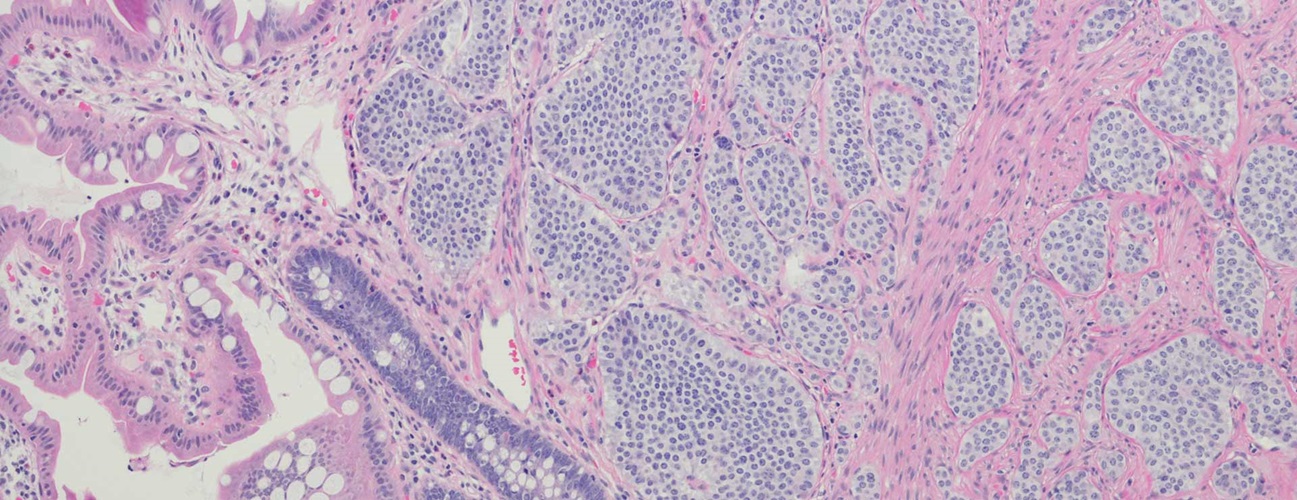Carcinoid Tumor
Reviewed By:
Carcinoid tumor, also called neuroendocrine tumor, is a rare type of tumor that usually grows slowly.
Carcinoid tumors are a heterogeneous group of tumors that can arise in different areas of the body. They are considered cancerous, but often take years to develop. You may have a carcinoid tumor for many years and never know it. However, some carcinoid tumors can be fast-growing. In rare cases, usually after a carcinoid tumor has spread, one may experience carcinoid syndrome — a result of hormones secreted by this tumor.
What You Need to Know Facts About Carcinoid Tumors
- Fewer than 10% of people with carcinoid tumors develop symptoms. The incidence of symptoms, however, may vary based on the location of the tumor. Because carcinoid tumors grow so slowly, they are usually not diagnosed until age 55 to 65.
- Gastrointestinal carcinoid tumors are more common in African Americans than Caucasians, and are slightly more common in women than men.
- The exact causes for the development of carcinoid tumors remain unclear. Most develop sporadically. There are some hereditary conditions, however, that increase the risk of development. These conditions include multiple endocrine neoplasia, Von Hippel-Lindau syndrome, neurofibromatosis type 1 and tuberous sclerosis.
- Carcinoid tumors originate from neuroendocrine cells, and they can grow anywhere in your body. These tumors sometimes secrete hormones, which are your body’s chemical messengers, that can cause symptoms. Most neuroendocrine tumors develop in the digestive (gastrointestinal) tract.
Types of Carcinoid Tumors
Here are the areas of the body where carcinoid tumors are usually found:
- Small intestine
- Appendix
- Rectum
- Lungs
- Colon
- Stomach
- Pancreas
- Liver
Carcinoid tumors behave differently depending on how quickly they grow, if they spread to other areas of your body and if they make hormones. Types of carcinoid tumors include:
- Slow-growing tumors: These tumors are the most common type. They usually remain small, typically less than 1 centimeter. They rarely grow quickly or spread to other areas of the body.
- Faster-growing tumors: These tumors may grow more rapidly and spread to other areas of the body.
- Hormone-secreting (functional) tumors: These functioning carcinoid tumors produce hormones such as insulin, gastrin, vasoactive intestinal peptide, glucagon, somatostatin or serotonin. Carcinoid syndrome occurs when the tumor produces excessive amounts of serotonin.
- Non-hormone-secreting (nonfunctional) tumors: These carcinoid tumors are the most common. They do not make any hormones.
Symptoms
Symptoms of carcinoid tumor depend on where the tumor is growing and whether the tumor is producing hormones. Some symptoms are triggered by exercise, stress and some foods or drinks, such as alcohol, chocolate and certain cheeses. In most cases, however, carcinoid tumors are nonfunctional and do not cause symptoms.
Symptoms related to tumor size/location:
- Abdominal pain or pressure
- Change in bowel habits
- Blood in a bowel movement
- Nausea or vomiting
- Chest pain
- Cough
- Blood-tinged sputum
- Weight loss
Symptoms related to the release of hormones:
- Facial flushing
- Diarrhea
- Elevated blood sugar
- Low blood sugar
- Ulcers
- Rashes
- Anxiety
- Confusion
- Heart palpitations
- Fainting
Symptoms related to carcinoid syndrome:
- Facial flushing
- Sweating
- Wheezing
- Shortness of breath
- Diarrhea
- Heart palpitations
- Heart murmur
- Low blood pressure
- Confusion
Diagnosis
Carcinoid tumors are often a diagnostic challenge because they are rare, slow-growing tumors that do not often produce symptoms. Most are identified on imaging obtained for another purpose or following a procedure for another condition, like an appendectomy.
If there is suspicion for a neuroendocrine tumor, tests/labs commonly employed include:
- X-ray: An X-ray is a way to create a picture of the structures inside the body using a small amount of radiation.
- Computed tomography (CT) scan: A CT scan takes pictures of the inside of the body using X-rays taken from different angles. A computer combines these pictures into a detailed, 3D image.
- Magnetic resonance imaging (MRI): An MRI uses magnetic fields to produce detailed images of the body.
- DOTATATE PET (positron emission tomography)/CT scan: A nuclear medicine scan that uses a special tracer (gallium-68 DOTATATE) to bind somatostatin receptors (proteins on the surface of carcinoid tumors). When the special tracer attaches to the somatostatin receptor and a picture is taken, these tumors glow like light bulbs.
- Biopsy: A biopsy is the removal of a small amount of tissue for examination under a microscope, and is required to make a diagnosis of carcinoid tumor.
- Urine test: If you have a carcinoid tumor that is making too much hormone, it may show up as a type of acid in your urine called 5 hydroxyindoleacetic acid. This is a waste product of serotonin.
- Blood test: A blood test may show an increased level of the hormone serotonin or high levels of chromogranin A. This is another substance made by most carcinoid tumors.
Treatment
The best treatment for small carcinoid tumors that have not spread is surgery. Surgery for these tumors can provide cure. Once a tumor has spread or become too big to remove, other treatment options are often pursued. Below is a list of treatment options that are often considered:
- Partial surgery (often called debulking surgery): If a tumor has spread to other parts of the body, surgery may be used to remove most of the tumor in order to control symptoms or aid in making other treatments work better.
- Chemotherapy: Medicines that fight carcinoid tumor cells may be given into your bloodstream or taken by mouth. These medicines are sometimes given in combination.
- Octreotide: This is a medicine that is given by injection. It helps control symptoms by decreasing the amount of hormones that carcinoid tumors make. This medicine can also slow tumor growth.
- Liver treatment: If a carcinoid tumor has spread to your liver, chemotherapy medicines may be injected into your liver, or small pellets may be injected that block blood flow to the tumor cells.
You may want to get a second opinion before starting treatment. Some insurance companies need one for certain cancer diagnoses. In addition to providing more information, a second opinion can also provide peace of mind regarding your treatment decisions.
Prevention
The exact causes for the development of carcinoid tumors remain unclear. Most develop sporadically. As a result, strategies to prevent the development of carcinoid tumor are not yet known. However, certain genetic and medical conditions are known to increase the risk of development. These conditions include multiple endocrine neoplasia, Von Hippel-Lindau syndrome, neurofibromatosis type 1 and tuberous sclerosis. Conditions that affect stomach acid, such as atrophic gastritis, pernicious anemia and Zollinger-Ellison syndrome, may also increase risk.
Managing Carcinoid Tumor
In addition to following all of your clinical team’s instructions, taking your medicines and keeping your appointments, you can help manage carcinoid tumor by learning as much as you can about the disease and taking an active role in your treatment. Here are some other suggestions:
- Follow a nutritious, high-protein diet.
- Avoid alcohol and foods that trigger carcinoid symptoms.
- Avoid stress as much as possible.
- Ask your doctor about the medicines you take. Some, such as decongestants, asthma inhalers and antidepressants, may trigger or make carcinoid symptoms worse.
- Join a support group to learn more about carcinoid tumors and share your feelings with others.
- Try mind-body exercises like yoga or tai chi to help reduce anxiety and stress.
- Try other ways of managing emotional stress: guided imagery, meditation, music therapy and journaling.
- Before appointments, write down your questions and bring them with you. For support during your appointments, bring a family member or close friend.
Home Remedies
Home remedies will not cure carcinoid tumors. Vitamin supplements may be helpful. Mineral supplements, such as potassium, magnesium and calcium, may also help. Freshly ground nutmeg will sometimes help control diarrhea. Always let your doctor know about any home remedies you want to try.







